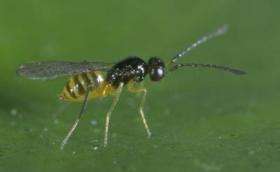Tiny Wasp Saves Pacific Island Paradise

It was a tourist bureau’s nightmare. A plant-killing invasive insect establishes a beachhead on a Pacific island paradise and quickly spreads, leaving tourists and locals who stroll down tree-lined promenades drenched in bug urine.
The news got worse for Tahitian and Mo’orean officials after UC Riverside Entomologist Mark Hoddle and UC Berkeley researcher Kenwyn Suttle discovered that many of the islands’ natural protectors, its spiders, died after eating the culprit, a half-inch long leaf hopper known as the glassy-winged sharpshooter. The sharpshooter has threatened the wine and citrus industries in California since the 1980s and is native to the southeastern U.S and northeastern Mexico.
The islands’ salvation came in the form of a microscopic parasitic wasp from Florida that is also helping to check the sharpshooter’s assault on the grape and wine industry in California.
A strong flyer, the glassy-winged sharpshooter has proved an unusually fast spreader of pathogens, such as Xylella fastidiosa, which causes Pierce’s disease that can kill a grapevine in just two years. The bacterium kills plants by stopping up their water conducting system, or xylem. The blockages reduce water flow to leaves. Water stress is visible as scorched leaves, which quickly dry and drop.
Hoddle and Suttle will be publishing their findings in an upcoming edition of the Journal Biological Invasions in a paper titled “Engineering Enemy-Free Space: An Invasive Pest that Kills its Predators.”
“During our feeding trials in Tahiti, we observed that some spiders would die after eating a sharpshooter, others would drop the sharpshooter soon after they touched it and would clean themselves assiduously,” Hoddle said. “In subsequent trials, of those spiders that survived, some of them stayed away from the sharpshooter but would readily attack a small fly offered to them.”
The trials, carried out in 2003 and 2004 showed that, two common native Tahitian spiders suffered what appeared to be intoxication and death rates ranging from a low of 43 percent to a high of 70 percent after eating their toxic prey.
“We’re not sure what makes the sharpshooter toxic to native spiders in French Polynesia, but we think the bacterium that attacks the grapevines (Xylella fastidiosa) may be responsible for protecting the sharpshooter from the native spiders,” Hoddle said. "At this stage it is unknown if Xylella is present in French Polynesia, but it could have arrived in infected ornamental plants imported from California."
The sharpshooter could have disrupted the food chains of entire islands because the direct lethal impacts on the spiders could have myriad indirect effects on competitors and their collective prey, according to the paper. The damage could have been amplified by the lack of natural checks that allowed the sharpshooter to achieve greater numbers than they do in their natural range.
Biological control, or the use of a pest’s natural enemies to keep it in check, was seen as a safe and effective way to protect French Polynesia from the sharpshooter.
Consequently, in May 2005, after safety evaluations were completed, Hoddle returned and began releasing the microscopic, stingless wasp, Gonatocerus ashmeadi, a natural enemy of the sharpshooter. The wasp lays its eggs inside those of the larger sharpshooter. The developing wasp larvae eat the contents of the sharpshooter egg thus killing the sharpshooter offspring. Adult wasps emerge to seek new sharpshooter eggs by chewing circular exit holes through the shell of the dead host eggs.
By the end of the 2005, Hoddle reported the sharpshooter had almost disappeared from the south pacific islands in which the wasp was released.
“It was a remarkable turnaround, needless to say, we were all stoked with the success of this program,” Hoddle said.
UC Riverside, the UC Berkeley Gump Station and the French Polynesian Government contributed to the biological control of glassy-winged sharpshooters and to the research in French Polynesia.
“The French Polynesian government now has an excellent researcher, trained at UCR, doing follow up work in Tahiti,” Hoddle said.
Source: University of California, Riverside


















